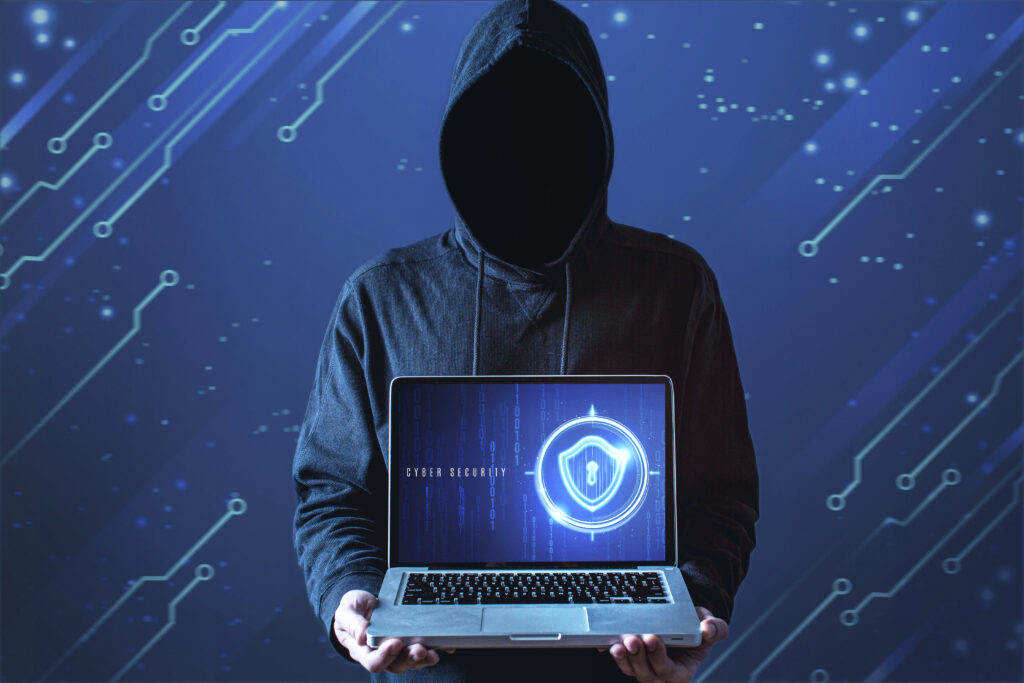In the expanding digital universe, where businesses, governments, and individuals depend on interconnected systems, cybersecurity threats have never been more common & serious. Among the most dangerous are black hat hackers, individuals who exploit vulnerabilities for financial gain or personal use, often causing destructive consequences.
This blog will explore who black hat hackers are and how they operate, what motivates them, and how their actions have shaped the digital security world through real-world case studies. Whether you’re a student, IT professional, or a concerned internet user, this guide will help you understand these digital villains and why safeguarding against them is essential.

Understanding the Term: What is a Black Hat Hacker?
The term “black hat” finds its roots in old Western films where villains wore black hats while heroes sported white ones. In cybersecurity, this comparison is still relevant. Here is a breakdown:
- Black Hat Hackers are unauthorized users who breach systems to steal, damage, or manipulate data.
- White Hat Hackers are ethical hackers who work to fix vulnerabilities and identify them.
- Grey Hat Hackers means individuals who operate in the grey zone, violating rules but not necessarily with malicious intent.
- Black hat hackers act illegally and unethically with goals ranging from financial theft and corporate spying to ideological disruption and political agendas
The Evolution of Black Hat Hacking
The world of black hat hacking has transformed significantly since the early days of computing
- 1970s-80s: Hacking was primarily exploratory. Teenagers accessed phone systems (phreaking) or mainframes.
- 1990s: The internet era saw the rise of cybercriminals exploiting businesses and governments.
- 2000s-Present: Professional cybercriminal groups and state-sponsored hackers emerged, launching sophisticated global attacks.
The evolution has been paralleled by technological growth, new tools, encrypted communication, and darknet markets have all contributed to the rise of highly organized cybercrime operations.
Characteristics of Black Hat Hackers
Black hat hackers vary in expertise and motivation, but most share these traits:
- Advanced Technical Skills mean they understand networks, operating systems, programming, and vulnerabilities.
- Motivation-driven means their goal is to shape their methods; some want money, others want fame, or political change.
- Stealth means many black hats cover their tracks using encryption, proxies, and anonymity tools like Tor.
- Persistence means they often study targets for weeks or months before launching an attack.
- Risk Acceptance means they knowingly violate laws and risk imprisonment, fines, or retaliation.
Tools and Techniques Used by Black Hat Hackers
Black hat hackers employ a blend of old and new technology to break into systems and instigate damage. These are some most common methods and tools utilized by these hackers:
1. Phishing and Social Engineering
These are deceptive methods used to trick users into revealing their private information. Legitimate-looking emails, websites, or messages are typical media.
2. Malware and Ransomware
Malware refers to any software created with the intent that cause damage. Ransomware specifically locks up your data and demands a payment to unlock it.
3. SQL Injection
Hackers target vulnerable websites that have SQL injections so they can compromise backend databases and also access user data.
4. Brute Force Attacks
A process that includes trying anything possible to guess the password or the encryption key.
5. Zero-day Exploits
These are security faults unknown to anyone that a hacker exploits before a software vendor has time to fix them.
6. Denial of Service (DOS) and Distributed DOS (DDOS)
Denial of Service(DOS) and Distributed DOS(DDOS) are attacks overwhelm a system or network with traffic to keep it from being usable.
Motivations Behind Black Hat Hacking
Understanding the motivations behind black hat hackers is crucial for preventing their actions:
1. Financial Gain is the top reason hackers do what they do. They often swipe credit card info, login details, or even hold systems hostage just to make a quick buck.
2. Corporate spying is another angle where some companies might illegally hire hackers to steal sensitive information or damage their competitors.
3. Political Activism or Hacktivism is where certain hackers use their skills to protest against governments, highlight injustices, or support causes, much like the group Anonymous.
4. National Interests come into play with State-Sponsored Attacks, where governments often recruit hackers to gather intelligence, disrupt foreign systems, or influence political outcomes.
5. Revenge is a motive for unsatisfied employees or individuals who might turn to hacking as a way to settle personal scores.
6. Curiosity or Ego drives some hackers; for them, it is all about the thrill of the challenge or proving their skills to gain respect in underground circles
Real-World Examples of Black Hat Hackers

To truly understand their impact, let us look at in famous black hat hackers and the attacks they conducted.
1. Kevin Mitnick from Hacker to Hero Timeline 1980 to 1995 Actions on breached networks of major corporations like IBM and Nokia. Specialized in social engineering and cloning cell phones. Impact created widespread fear about cyber threats. After that, he was arrested in 1995 and sent to five years in jail. Later became a cybersecurity expert and author.
2. Albert Gonzalez The Data Thief Timeline 2005 to 2008 Actions done orchestrated one of the largest credit card theft operations and stole 170+ million card numbers. The method used SQL injections and sniffed data from corporate networks. Impact cost companies like TJX and Heartland hundreds of millions in damages. After that, he was put in federal prison for 20 years.
3. Gary McKinnon, the UFO hunter, Timeline 2001 to 2002. Actions hacked 97 U.S. military and NASA systems. Claim he was searching for information on UFOs and free energy technologies. The impact caused system outages, deleted files, and raised alarm over poor cybersecurity. After that, he spent ten long years battling extradition, but in the end, he was granted permission to remain in the UK.
4. Anonymous, the Hacktivist Collective, has lived in since mid-2000. Nature is a loosely organized group that performs politically motivated cyberattacks. Actions attacked the Church of Scientology, Sony, and PayPal. Supported WikiLeaks and took down ISIS propaganda sites. Methods: DDoS attacks, doxxing, and website defacement. Outcome: many members arrested, but the group still operates globally
Global Impact of Black Hat Hackers
The consequences of black hat hacking extend far beyond the digital realm:
1. Economic Damage
Cybercrime is expected to hit the global economy with a staggering cost of over $10.5 trillion each year by 2025, as reported by cybersecurity ventures.
2. Public safety risks
Attacks on hospitals, transportation, and infrastructure systems can endanger lives.
3. Loss of trust
Companies suffer irreparable brand damage after data breaches.
4. Legal & regulatory consequences
Organizations may face lawsuits, fines under GDPR, and loss of customer trust.
5. National Security Threats
State-sponsored attacks can interfere with elections, defense systems, and diplomacy.
How to Protect Yourself and Your Organization
Cybersecurity is everyone’s responsibility.
Here are some steps:
For individuals:
- Use strong, unique passwords.
- Enable 2FA Two Factor Authentication.
- Don’t click on doubtful links or attachments.
- Keep software and devices up to date.
- Use a reputable antivirus & firewall.
For businesses:
- Regular vulnerability assessments.
- Conduct security awareness training.
- Use endpoint protection platforms.
- Implement backup & disaster recovery plans.
- Invest in threat detection & response systems.
Future of Black Hat Hacking

As technology evolves, so do threats. Black hat hackers are beginning to:
Leverage AI & machine learning:
For smarter phishing attacks and automated exploits.
Target IOT Devices:
Smart homes and connected appliances are becoming vulnerable.
Exploit Cloud Infrastructure:
As businesses migrate to the cloud, hackers follow.
Detect AI-generated text and convert it into something that feels more humanised with our AI Content Detector. Just paste your text and in a matter of seconds, you will receive accurate, relatable results by using it!
Here is the text to analyze. It is about impersonating executives or scamming individuals. Organizations and people need to adapt swiftly to protect themselves from these rising threats.
Conclusion
Black hat hackers are real and continuing to grow in the digitally connected world. Tactics keep evolving, looking for loopholes to exploit for financial gain or political motives, or arguably personal challenge. From high-profile breaches to silent data thefts, they have their hands in everything, making an impact far-reaching and destructive. Understanding the identity of these hackers and their mode of operation allows businesses and individuals to take intelligent and proactive steps to defend themselves against them. Cybersecurity is no longer optional; it is a necessity for awareness, preparation, and digital safety commitment are what it takes to stay one step ahead
